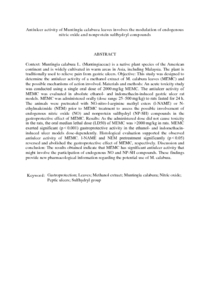Citation
Balan, Tavamani and Mohd Sani, Mohd Hijaz and Suppaiah, Velan and Mohtarrudin, Norhafizah and Suhaili, Zarizal and Ahmad, Zuraini and Zakaria, Zainul Amiruddin
(2014)
Antiulcer activity of Muntingia calabura leaves involves the modulation of endogenous nitric oxide and nonprotein sulfhydryl compounds.
Pharmaceutical Biology, 52 (4).
pp. 410-418.
ISSN 1388-0209; ESSN: 1744-5116
Abstract
Context: Muntingia calabura L. (Muntingiaceae) is a native plant species of the American continent and is widely cultivated in warm areas in Asia, including Malaysia. The plant is traditionally used to relieve pain from gastric ulcers. Objective: This study was designed to determine the antiulcer activity of a methanol extract of M. calabura leaves (MEMC) and the possible mechanisms of action involved. Materials and methods: An acute toxicity study was conducted using a single oral dose of 2000 mg/kg MEMC. The antiulcer activity of MEMC was evaluated in absolute ethanol- and indomethacin-induced gastric ulcer rat models. MEMC was administered orally (dose range 25–500 mg/kg) to rats fasted for 24 h. The animals were pretreated with NG-nitro-l-arginine methyl esters (l-NAME) or N-ethylmaleimide (NEM) prior to MEMC treatment to assess the possible involvement of endogenous nitric oxide (NO) and nonprotein sulfhydryl (NP-SH) compounds in the gastroprotective effect of MEMC. Results: As the administered dose did not cause toxicity in the rats, the oral median lethal dose (LD50) of MEMC was >2000 mg/kg in rats. MEMC exerted significant (p < 0.001) gastroprotective activity in the ethanol- and indomethacin-induced ulcer models dose-dependently. Histological evaluation supported the observed antiulcer activity of MEMC. l-NAME and NEM pretreatment significantly (p < 0.05) reversed and abolished the gastroprotective effect of MEMC, respectively. Discussion and conclusion: The results obtained indicate that MEMC has significant antiulcer activity that might involve the participation of endogenous NO and NP-SH compounds. These findings provide new pharmacological information regarding the potential use of M. calabura.
Download File
![[img]](http://psasir.upm.edu.my/36502/1.hassmallThumbnailVersion/Antiulcer%20activity%20of%20Muntingia%20calabura%20leaves%20involves%20the%20modulation%20of%20endogenous%20nitric%20oxide%20and%20nonprotein%20sulfhydryl%20compounds.pdf)  Preview |
|
PDF (Abstract)
Antiulcer activity of Muntingia calabura leaves involves the modulation of endogenous nitric oxide and nonprotein sulfhydryl compounds.pdf
Download (185kB)
| Preview
|
|
Additional Metadata
Actions (login required)
 |
View Item |

